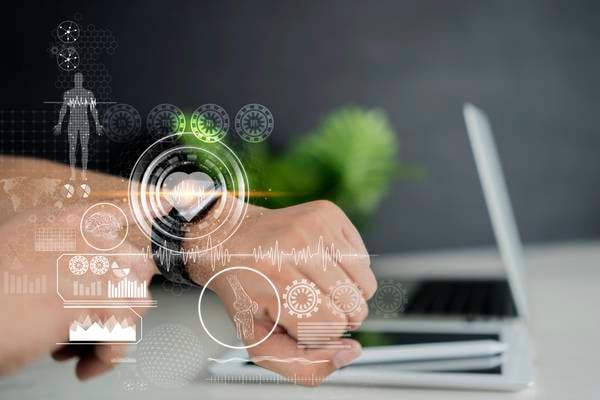Whether it’s a smart watch, fitness tracker or virtual reality headset, the use of wearable technology has become commonplace in Ireland in recent years, with people integrating it into many aspects of their lives.
People use smartwatches to record health information such as VO2 max (the amount of oxygen your body uses during strenuous exercise), resting heart rate, sleep patterns, and various other variables related to health and wellness. In many cases, they use this data to understand and improve health and to guide lifestyles.
However, beyond counting steps or calories burned, for healthcare professionals and healthcare systems this increasing use of wearables offers an incredible opportunity to improve health outcomes at the individual and population level. This is because wearable technology, properly integrated into healthcare systems where data is interoperable – shared rather than isolated – can play a key role in understanding key factors influencing health at a population level and can provide useful insights to improve health and benefits.
At the individual level, where the problems are the treatment and cure of pre-existing disease, they also offer the potential to be part of the solution, in turn reducing the burden on an already overburdened health service.
EY’s Future Consumer Index of more than 22,000 global consumers published reveals that people have accepted the tracking of their own data and regularly use tracking apps. Nearly half of respondents (46 percent) track their exercise, nearly four in 10 (38 percent) track their heart rate, one-third (33 percent) track their calorie intake, and one in four (25 percent) say they follow a meal plan prepared by an app.

Here in Ireland there is a strong appetite for the transition to a digitally enabled health system and the sharing of personal health-related data if it can be used in the right way to manage and improve health. Last summer, EY surveyed more than 1,000 people in Ireland as part of our global consumer health survey. We found that seven in 10 (72 percent) were in favor of automatic electronic sharing of their personal medical information within the healthcare system.
We also found that a similar majority (70 percent) are willing to share health information captured by a wearable device with clinicians, while people are also strongly in favor of sharing biometric (78 percent), lifestyle (75 percent) and genetic (67 percent) data with healthcare professionals. who manage their care to improve overall health outcomes.
Sláintecare, our national health strategy, is about delivering the right care, in the right place, at the right time. To ensure that data, analytics, artificial intelligence (AI) and wearable technology support the realization of this strategy, a number of challenges need to be overcome.
From the perspective of wearables – or any other modern technology solution – part of the challenge lies in how to deploy them in an integrated way that connects data from the individual to the system, that protects patient privacy and rights, and that ensures true clinical oversight. Members of the population can wear a 24-hour blood pressure monitor to guide hypertension treatment. However, typically the device will not “talk” directly to the health information and communication technology (ICT) infrastructure, so the data generated cannot be used in real time – or in reality anything close to it. Instead, it needs to be downloaded, loaded and analyzed. This type of hidden data is all too common in the healthcare system with monitoring devices.

Currently, our health ICT infrastructure does not allow the necessary flexible data exchange and ultimately the usability of health data. There is also a gap in the clinical education of medical professionals about how data and analytics can deliver care to individuals and populations, which will need to be addressed.
Population analysis powered by data from wearable technology can enable risk stratification by specific lifestyle and risk factors and “advise” based on an individual’s data-driven well-being profile. In extreme cases, wearable devices could save a life if they are enabled to detect critical incidents and alert the appropriate clinical services.
Although their use globally is still in its early stages, there have been a number of encouraging studies, including a small US trial of the BioStamp nPoint wearable system for remote patient monitoring, which has suggested accurate and reliable data for biometric monitoring in clinical and remote settings. delivered.
In addition, wearables can enable younger members of the population to take responsibility for their own health in very meaningful ways that will yield huge long-term benefits.
Personalized lifestyle advice or clinical interventions can be generated using indicators picked up by the device at a very early stage. Innovations like this are key – we have an aging population combined with increasingly individualized models of care which means the demands on healthcare delivery will only increase in the coming years, and technology such as wearables can improve population health outcomes and healthcare delivery .
The integration of wearables with AI and Generative AI offers even more potential. Although AI has been used in areas such as mammography for some time, Generative AI can potentially detect and explore new and more complex patterns in wearable device results that can be applied to a number of different scenarios to see if there is a correlation between them. Data beyond pure diagnostics (for example, lifestyle risk factors) can be incorporated into algorithms and combined with data from mammography, for example, to allow us to understand much earlier the likelihood of developing breast cancer – and thus the possibility of lifestyle intervention or other factors to optimally manage this risk.
Leaders in Irish healthcare have an opportunity to build on the progress made so far and take full advantage of wearable data to take full advantage of some of the incredible technological advances we see around us. Research tells us that health benefits at the individual and population level are significant for current and future generations, and that the time to act is now.
- dr. Mary Coghlan is a partner at EY Ireland where she leads the healthcare data and analytics practice. She is a qualified physician, actuary and analytics expert who supports organizations in using advanced health analytics to support better health outcomes for populations